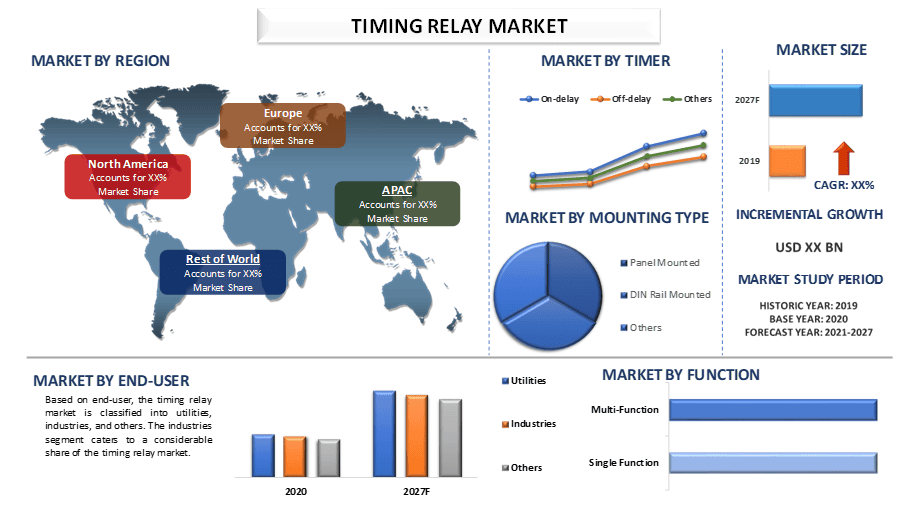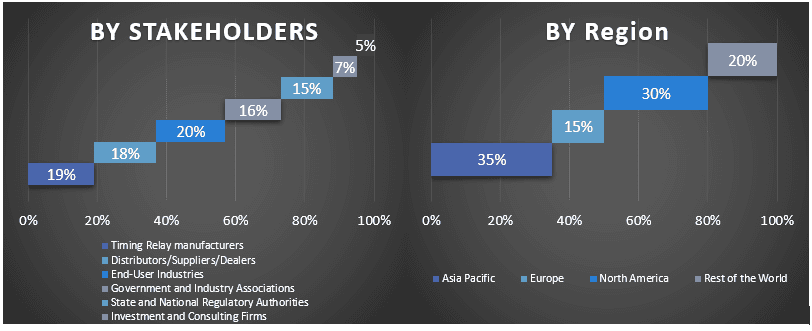- الرئيسية
- معلومات عنا
- صناعة
- الخدمات
- قراءة
- اتصل بنا
سوق مرحلات التوقيت: التحليل الحالي والتوقعات (2021-2027)
التركيز على المؤقت (تأخير التشغيل، تأخير الإيقاف، وغيرها)، نوع التركيب (تركيب على اللوحة، تركيب على سكة DIN، وغيرها)، الوظيفة (وظيفة واحدة ووظائف متعددة)، المستخدم النهائي (المرافق والصناعات وغيرها)، والمنطقة والبلد

من المتوقع أن ينمو سوق مرحلات التوقيت العالمي بمعدل نمو سنوي مركب يبلغ حوالي 5.5٪ خلال الفترة المتوقعة (2021-2027). تلبي مرحلة التوقيت طلبًا واسعًا في السوق في جميع أنحاء العالم ومن المتوقع أن تشهد معدل نمو مؤثرًا في الفترة المتوقعة أيضًا. إنه جهاز كهربائي للتحكم الآلي يستخدم مبدأ العمل الكهرومغناطيسي أو الميكانيكي لتأخير إغلاق أو فتح جهات الاتصال. العوامل التي تؤثر بشكل إيجابي على حجم سوق مرحلات التوقيت هي التطور الهائل في نظام النقل وتوليد الطاقة في الاقتصادات الناشئة إلى جانب زيادة اعتماد تطبيقات التدفئة والتهوية وتكييف الهواء (HVAC) في جميع أنحاء العالم.
علاوة على ذلك، مع تزايد المباني التجارية على مستوى العالم، يزداد الطلب على مرحلات التوقيت في أنظمة تكييف الهواء والمصاعد والإضاءة والأجهزة الأخرى. يعتمد الاستخدام الآمن وعمل هذه الأجهزة على عمل مرحلات التوقيت. من المتوقع أن يؤدي تزايد الطلب على أجهزة التحكم في العديد من الصناعات وتوافر نطاقات زمنية واسعة إلى دفع الطلب على مرحلات التوقيت خلال الفترة المتوقعة.
مرحلة التوقيت، المستخدم النهائي، 2020

شركة جنرال إلكتريك، وشركة ABB Ltd.، وشركة سيمنز AG، وشركة إيتون plc، وشركة G&W Electric Company، وشركة هابل المدمجة، وشركة شنايدر إلكتريك SE، وشركة روكويل أوتوميشن، وشركة ميتسوبيشي إلكتريك، وشركة S&C Electric Company. تم إجراء العديد من عمليات الاندماج والاستحواذ جنبًا إلى جنب مع الشراكات من قبل هؤلاء اللاعبين لتزويد العملاء بمنتجات/تقنيات عالية التقنية ومبتكرة.
الرؤى المقدمة في التقرير
"من بين المؤقتات، يحظى الجزء الموجود في وضع التأخير بأكبر حصة"
استنادًا إلى المؤقت، يتم تصنيف سوق مرحلات التوقيت إلى وضع التأخير ووضع الإيقاف المؤقت وغير ذلك. يخدم قطاع وضع التأخير حصة سوقية واسعة في سوق مرحلات التوقيت ومن المتوقع أن يكون القطاع الأسرع نموًا في الفترة المتوقعة. إن نمو القطاع الصناعي في الاقتصادات الناشئة يؤدي إلى ارتفاع الطلب على مرحلات التوقيت في وضع التأخير لأنه ببساطة يتحكم في المرحلات بوظيفة تأخير زمني مدمجة تساعد في التحكم في حدث ما، عن طريق تنشيط الدائرة الثانوية، بعد فترة معينة من الوقت.
"من بين أنواع التركيب، يحظى جزء تركيب اللوحة بأكبر حصة"
استنادًا إلى نوع التركيب، يتم تصنيف سوق مرحلات التوقيت إلى مثبتة على اللوحة، ومثبتة على سكة DIN، وغيرها. يوفر التركيب على اللوحة حصة سوقية كبيرة في سوق مرحلات التوقيت. يتم نشر مرحلات التوقيت المثبتة على اللوحة في تطبيقات مثل التدفئة/تكييف الهواء، ومضخات الحرارة، ومعالجة النفايات، والمعدات الطبية، والتحكم في الوصول، ومعالجة المياه والهواء. من المتوقع أن يؤدي تزايد الطلب على تطبيقات التدفئة والتهوية وتكييف الهواء (HVAC) وزيادة الاستثمارات في قطاع المياه والصرف الصحي إلى دفع قطاع تركيب اللوحة في سوق مرحلات التوقيت.
"من بين المستخدمين النهائيين، يحظى قطاع الصناعات بأكبر حصة"
استنادًا إلى المستخدم النهائي، يتم تصنيف سوق مرحلات التوقيت إلى المرافق والصناعات وغيرها. يقدم قطاع الصناعات حصة كبيرة من سوق مرحلات التوقيت. ويرجع ذلك أساسًا إلى زيادة الصناعات في الاقتصادات الناشئة التي تؤثر بشكل إيجابي على تطبيق مرحلات التوقيت. ويرجع ذلك أساسًا إلى الحاجة المتزايدة إلى التوقيت الدقيق والفولتية والتحكم في الوظائف لمصنعي المعدات الأصلية (OEM) في التطبيقات الصناعية مما يخلق طلبًا على تحسين عمل مرحلات التوقيت ويجعل هناك حاجة كبيرة للسوق.
"تمثل منطقة آسيا والمحيط الهادئ واحدة من الحصص السوقية الواسعة لسوق مرحلات التوقيت العالمي"
من أجل فهم أفضل لديناميكيات السوق لمرحلات التوقيت العالمية. من المتوقع أن تشهد منطقة آسيا والمحيط الهادئ أعلى معدل نمو خلال الفترة المتوقعة، وذلك بسبب النمو المتزايد للقطاع الصناعي، ومن المرجح أن يخلق قطاع النقل حاجة كبيرة لمرحلات التوقيت في السنوات القادمة. بالإضافة إلى ذلك، فإن ارتفاع الطلب على الكهرباء، وزيادة إضافات قدرة توليد الطاقة، ونمو الصناعات التحويلية تعمل على تصعيد مرحلات توقيت السوق في المنطقة.
أسباب شراء هذا التقرير:
- تتضمن الدراسة تحليلًا لحجم السوق والتنبؤ به تم التحقق منه من قبل خبراء الصناعة الرئيسيين المعتمدين.
- يقدم التقرير مراجعة سريعة للأداء العام للصناعة في لمحة واحدة.
- يغطي التقرير تحليلًا متعمقًا لأقران الصناعة البارزين مع التركيز الأساسي على البيانات المالية الرئيسية للأعمال، ومحافظ المنتجات، واستراتيجيات التوسع، والتطورات الأخيرة.
- دراسة تفصيلية للمحركات والقيود والاتجاهات الرئيسية والفرص السائدة في الصناعة.
- تغطي الدراسة بشكل شامل السوق عبر قطاعات مختلفة.
- تحليل متعمق على المستوى الإقليمي للصناعة.
خيارات التخصيص:
يمكن تخصيص سوق مرحلات التوقيت العالمي بشكل أكبر حسب المتطلبات أو أي شريحة سوقية أخرى. إلى جانب ذلك، تدرك UMI أن لديك احتياجات عمل خاصة بك، لذا لا تتردد في التواصل معنا للحصول على تقرير يناسب متطلباتك تمامًا.
جدول المحتويات
كان تحليل السوق التاريخي وتقدير السوق الحالي والتنبؤ بالسوق المستقبلي لسوق مرحل التوقيت العالمي هي الخطوات الرئيسية الثلاث التي تم اتخاذها لإنشاء وتحليل اعتماد مرحل التوقيت في المناطق الرئيسية على مستوى العالم. تم إجراء بحث ثانوي شامل لجمع أرقام السوق التاريخية وتقدير حجم السوق الحالي. ثانيًا، للتحقق من صحة هذه الرؤى، تم أخذ العديد من النتائج والافتراضات في الاعتبار. علاوة على ذلك، تم أيضًا إجراء مقابلات أولية شاملة مع خبراء الصناعة عبر سلسلة القيمة لسوق مرحل التوقيت العالمي. بعد افتراض أرقام السوق والتحقق من صحتها من خلال المقابلات الأولية، استخدمنا نهجًا من أعلى إلى أسفل/من أسفل إلى أعلى للتنبؤ بحجم السوق الكامل. بعد ذلك، تم اعتماد طرق تقسيم السوق وتثليث البيانات لتقدير وتحليل حجم السوق للقطاعات والقطاعات الفرعية الخاصة بالصناعة. يتم شرح المنهجية التفصيلية أدناه:
اطلب المزيد من التفاصيل حول منهجية البحث
تحليل حجم السوق التاريخي
الخطوة 1: دراسة متعمقة للمصادر الثانوية:
تم إجراء دراسة ثانوية تفصيلية للحصول على حجم السوق التاريخي لسوق مرحل التوقيت من خلال المصادر الداخلية للشركة مثل التقارير السنوية والبيانات المالية وعروض الأداء والنشرات الصحفية وما إلى ذلك، والمصادر الخارجية بما في ذلك المجلات والأخبار والمقالات والمنشورات الحكومية ومنشورات المنافسين وتقارير القطاعات وقاعدة بيانات الطرف الثالث والمنشورات الأخرى ذات المصداقية.
الخطوة 2: تقسيم السوق:
بعد الحصول على حجم السوق التاريخي لسوق مرحل التوقيت، أجرينا تحليلًا ثانويًا مفصلاً لجمع رؤى السوق التاريخية ومشاركتها للقطاعات والقطاعات الفرعية المختلفة للمناطق الرئيسية. يتم تضمين القطاعات الرئيسية في التقرير كمؤقت ونوع التركيب والوظيفة والمستخدم النهائي والمنطقة. تم إجراء المزيد من التحليلات على مستوى الدولة لتقييم الاعتماد الكلي لنماذج الاختبار في تلك المنطقة.
الخطوة 3: تحليل العوامل:
بعد الحصول على حجم السوق التاريخي للقطاعات والقطاعات الفرعية المختلفة، أجرينا تحليل عوامل مفصل لتقدير حجم السوق الحالي لسوق مرحل التوقيت. علاوة على ذلك، أجرينا تحليلًا للعوامل باستخدام متغيرات تابعة ومستقلة مثل زيادة الطلب على المعدات الكهربائية إلى جانب التركيز المتزايد على توليد الطاقة المتجددة. تم إجراء تحليل شامل لسيناريوهات جانب الطلب والعرض مع الأخذ في الاعتبار أهم الشراكات وعمليات الاندماج والاستحواذ والتوسع التجاري وإطلاق المنتجات في قطاع سوق مرحل التوقيت في جميع أنحاء العالم.
تقدير حجم السوق الحالي والتنبؤ به
تقدير حجم السوق الحالي: بناءً على الرؤى القابلة للتنفيذ من الخطوات الثلاث المذكورة أعلاه، توصلنا إلى حجم السوق الحالي واللاعبين الرئيسيين في سوق مرحل التوقيت العالمي والحصص السوقية للقطاعات. تم تحديد جميع تقسيمات الحصص المئوية المطلوبة وتقسيمات السوق باستخدام النهج الثانوي المذكور أعلاه وتم التحقق منها من خلال المقابلات الأولية.
التقدير والتنبؤ: لتقدير السوق والتنبؤ به، تم تخصيص أوزان لعوامل مختلفة بما في ذلك المحركات والاتجاهات والقيود والفرص المتاحة لأصحاب المصلحة. بعد تحليل هذه العوامل، تم تطبيق تقنيات التنبؤ ذات الصلة، أي النهج من أعلى إلى أسفل/من أسفل إلى أعلى، للتوصل إلى توقعات السوق لعام 2027 للقطاعات والقطاعات الفرعية المختلفة عبر الأسواق الرئيسية على مستوى العالم. تتضمن منهجية البحث المعتمدة لتقدير حجم السوق ما يلي:
- حجم سوق الصناعة، من حيث القيمة (بالدولار الأمريكي) ومعدل اعتماد سوق مرحل التوقيت عبر الأسواق الرئيسية محليًا
- جميع الحصص المئوية والتقسيمات والتحليلات التفصيلية لقطاعات السوق والقطاعات الفرعية
- اللاعبون الرئيسيون في سوق مرحل التوقيت العالمي من حيث الفئة المعروضة. أيضًا، استراتيجيات النمو التي يتبناها هؤلاء اللاعبون للتنافس في السوق سريع النمو
التحقق من صحة حجم السوق والحصة السوقية
البحث الأولي: تم إجراء مقابلات متعمقة مع قادة الرأي الرئيسيين (KOLs) بما في ذلك كبار المديرين التنفيذيين (CXO/VPs، رئيس قسم المبيعات، رئيس قسم التسويق، الرئيس التشغيلي، الرئيس الإقليمي، رئيس الدولة، إلخ) عبر المناطق الرئيسية. ثم تم تلخيص نتائج البحث الأولي وإجراء تحليل إحصائي لإثبات الفرضية المذكورة. تم دمج المدخلات من البحث الأولي مع النتائج الثانوية، وبالتالي تحويل المعلومات إلى رؤى قابلة للتنفيذ.
تقسيم المشاركين الرئيسيين في المناطق المختلفة

هندسة السوق
تم استخدام تقنية تثليث البيانات لإكمال تقدير السوق الإجمالي والتوصل إلى أرقام إحصائية دقيقة لكل قطاع وقطاع فرعي من سوق مرحل التوقيت العالمي. تم تقسيم البيانات إلى عدة قطاعات وقطاعات فرعية بعد دراسة المعلمات والاتجاهات المختلفة في مجالات المؤقت ونوع التركيب والوظيفة والمستخدم النهائي في سوق مرحل التوقيت العالمي.
الهدف الرئيسي من دراسة سوق مرحل التوقيت العالمي
تم تحديد اتجاهات السوق الحالية والمستقبلية لسوق مرحل التوقيت العالمي في الدراسة. يمكن للمستثمرين الحصول على رؤى استراتيجية لترسيخ تقديرهم للاستثمارات على التحليل النوعي والكمي الذي تم إجراؤه في الدراسة. حددت اتجاهات السوق الحالية والمستقبلية الجاذبية الإجمالية للسوق على المستوى الإقليمي، مما يوفر منصة للمشارك الصناعي لاستغلال السوق غير المستغلة للاستفادة من ميزة المحرك الأول. تشمل الأهداف الكمية الأخرى للدراسات ما يلي:
- تحليل حجم السوق الحالي والمتوقع لسوق مرحل التوقيت من حيث القيمة (بالدولار الأمريكي). أيضًا، تحليل حجم السوق الحالي والمتوقع للقطاعات والقطاعات الفرعية المختلفة
- تشمل القطاعات في الدراسة مجالات المؤقت ونوع التركيب والوظيفة والمستخدم النهائي.
- تحديد وتحليل الإطار التنظيمي لصناعة سوق مرحل التوقيت.
- تحليل سلسلة القيمة المتضمنة مع وجود وسطاء مختلفين، إلى جانب تحليل سلوكيات العملاء والمنافسين في الصناعة.
- تحليل حجم السوق الحالي والمتوقع لسوق مرحل التوقيت للمنطقة الرئيسية.
- تشمل المناطق الرئيسية التي تمت دراستها في التقرير منطقة آسيا والمحيط الهادئ وأوروبا وأمريكا الشمالية وبقية العالم.
- ملفات تعريف الشركة لسوق مرحل التوقيت واستراتيجيات النمو التي يتبناها اللاعبون في السوق للحفاظ على الاستدامة في السوق سريع النمو
تحليل متعمق على المستوى الإقليمي للصناعة
ذات صلة التقارير
العملاء الذين اشتروا هذا المنتج اشتروا أيضًا










